
It
is not just the race for
the White House that is
making news—next
week Emirates launches
its first flights from
Washington, D.C., with
an event that competes
very nicely with the best
Presidential galas, which
are scheduled directly
after the upcoming Fall
2102 elections.
EK
starting service on September
12 will be marked with
what is sure to be a grand
soiree in Washington,
D.C..
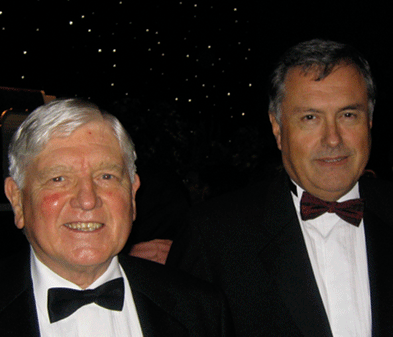 For
air cargo that means a
big customer party as
well, with EK pulling
out all the stops as per
usual.
For
air cargo that means a
big customer party as
well, with EK pulling
out all the stops as per
usual.
An
airline launch party “the
way it ought to be”
is nothing new, although
in the grand scheme of
things, Emirates has undoubtedly
elevated the form to a
point untouched by other
carriers.
Who
can forget the EK USA
launch a few years back
at Cipriani on West 42nd
Street in Manhattan? Under
the shadow of Grand Central
Station, CEO Maurice Flanagan
(pictured with Nigel Page)
hosted six hundred guests,
as singer Tom Jones belted
out tunes over tables
with bowls of caviar big
enough to swim in.
All
of this is probably (as
Yogi Berra would say)
like déjà
vu all over again to Emirates
top USA cargo executive,
Ed Chism.
You
see, once upon a time
Mr. Ed was a top cargo
executive at Pan American
Clipper Cargo.
If
there is one thing that
last year’s short-lived
Pan Am TV series taught
us, it is that PAA wrote
the book on deluxe first
class travel and had the
best high-flying airline
parties.
We
wrote a lot about Ed earlier
this year.
As
Washington, D.C. goes
live in the Emirates global
network, a story from
the recent past is affectionately
presented here once again.
Good
luck to EK Cargo (and
the passenger side as
well), as next week even
more history is made in
the Dubai carrier’s
climb to the top of the
international airline
business.
Geoffrey

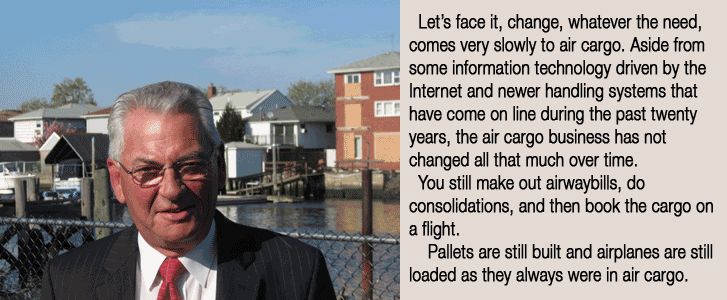 |
Every
once in a lifetime (or
in my racket, if you are
really lucky, a couple
of times), you get to
talk to somebody who truly
lights up the room.
It
is Ed Chism’s presentation,
experience, wisdom, positive
point of view, and cutting
right to the chase that
sets this air cargo executive
apart.
Ed
has been in the cargo
business since Lyndon
Johnson was U.S. President
and apparently has loved
every minute of it, which
made my recent talk with
him in New York such a
great experience.
Now
that I think about it,
later this month another
talk I had with KLM’s
Jacques Ancher will run
in these pages, and not
for the first time.
Air
cargo has some really
interesting individuals,
both men and women, for
which it should be thankful.
It
is our intention to try
and talk to every single
one of them.
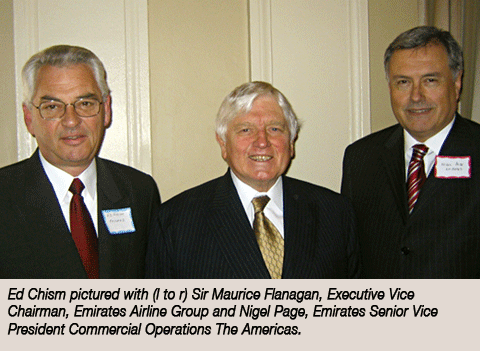 Today
in air cargo, nobody is
flying higher than Emirates
SkyCargo.
Today
in air cargo, nobody is
flying higher than Emirates
SkyCargo.
While
we write quite a bit about
Emirates, its people,
and the places and developments
of the airline, it’s
safe to say that the EK
SkyCargo story and product
rarely (if ever) disappoint.
We
spent a very good afternoon
recently with SkyCargo’s
point man in America,
Ed Chism.
Ed
is Cargo Manager North
America and is also old-school
air cargo, meaning he
has been humping and moving
freight around the world
since he was 19 years
old. Now some 43-plus
years later, he has managed
to keep abreast of industry
developments and finds
himself where he always
was, out front and leading
the way whilst delivering
valuable air cargo revenue
to a great international
airline from his base
in New York City.
Sometimes the sweet story
can be as exciting and
memorable as any other.
Ed
Chism drives up in a sleek,
low-slung BMW, an Emirates
car that looks like something
out of the movie The Transporter;
a motor that appears to
be in motion even while
parked and sitting perfectly
still.
We
meet in a small Italian
seafood restaurant over
on Cross Bay Boulevard
near JFK International
in Howard Beach, just
down the road from Russo’s
where all the airport
cargo events are held.
The
place is called Vincent’s
and not only is this venue
a genuine joint and one
of the best places anywhere,
the restaurant is also
near the social club once
populated by the likes
of John Gotti and Henry
Hill, the infamous mob
stooge and subject of
director Martin Scorsese’s
Goodfellas.
Goodfellas,
among other things, tells
of the Lufthansa Cargo
heist at JFK during a
time when air cargo at
the big airport was considered
a personal shopping mall
for neighborhood gangsters.
But
Ed and I were younger
at the time, and while
I was chasing copy and
pushing deadlines for
our original air cargo
newspaper Air Cargo News,
Ed Chism was well on his
way to building a career
after beginning as a mere
lad at legendary Pan American
Airways Clipper Cargo.
Today
with my tape recorder
in hand (which is turned
off when we really talk)
we lose no time getting
down to cases.
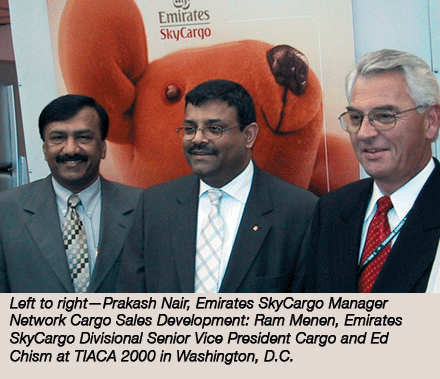 “Pan
Am was there at the beginning
of so many things important
to aviation and air cargo.
“Pan
Am was there at the beginning
of so many things important
to aviation and air cargo.
“But
Emirates picked up the
flag of forward thinking
and innovation on the
first day in business
and has never backed down
a bit since 1985.
“My
view is that our DVSP
Ram Menen is both a global
leader in the business
and also a visionary in
air cargo.”
Those
words from Ed, who worked
with many of the legendary
leaders of air cargo,
bear some further consideration.
Ed
worked with Bill Boesch,
Thor Johnson and a host
of others at Pan Am and
around the world. He rose
from an entry clerk at
PAA to waking up one day
and having the rather
sad and thankless task
of closing down Pam Am
Clipper Cargo altogether
at Building 67, JFK, when
the great airline was
finally grounded forever
in December 1991.
“I
was always fascinated
with airplanes and the
airlines.
“A
friend of mine worked
for American Airlines
so I asked him if there
were any jobs at AA and
he said no, but that he
heard that Pan Am was
hiring.
“So
at 19 I went to JFK PAA
Hangar 14, put in an application
and they asked me if I
could type and I replied:
“‘Sort
of.’
“They
told me there were some
openings in cargo and
although I wasn’t
much interested in the
field, I indicated interest,
figuring that was a good
way to get my foot in
the door.
“Air
cargo is where I started
and stayed for the past
43 years.
“I
worked for Pan Am for
25 years.
“I
had actually started in
Building 67 the week it
opened, driving a forklift
in Import on the midnight
shift with Tuesdays and
Wednesdays off.
“We
were not automated much
at the time except for
the Flow Access System,
which was basically the
first FedEx system several
decades before that company
went into business.
“Building
67 was designed for B707s
so most cargo were small
packages.
 “The
system was not perfected,
and when the B747s came
on, we ripped it out so
that we could build up
containers and pallets
and other unitized freight.
“The
system was not perfected,
and when the B747s came
on, we ripped it out so
that we could build up
containers and pallets
and other unitized freight.
“I
did all the jobs and finally
worked in a satellite
unit in the passenger
terminal that coordinated
the freight on and off
the flights as my first
management experience.
“Later
as a supervisor and a
duty manager in both import
& export, I moved
up to director of ramp
operations at a time when
JFK International was
Pan Am hub for six B747
freighters.
“At
that point I was in charge
of postal activities,
cargo ramp, and also coordinating
freight, both passenger
and all cargo.
“When
in the mid 1980s Clipper
Cargo headquarters moved
from Manhattan to Building
67, my job under Thor
Johnson was worldwide
director of sales and
services, where I served
until the airline shut
down.
“Looking
back, I learned everything
at Pan Am.
“From
documentation to U.S.
Customs to all the regulatory
authority requirements
to security, you did it
all—you had to do
it all and that was it.
“I
guess my entrepreneurial
spirit was greatly helped
along by that experience
because just after the
airline went out of business,
I declined to join Pan
Am II, preferring to open
my GSA company at JFK
International off airport
in Springfield Gardens.
“We
had several companies
that we conducted various
tasks for, including consulting,
but Emirates was among
our first accounts, and
eventually Emirates grew
into our biggest.
“Our
association began with
a presentation for Ram
Menen, which he accepted.
“In
1993, Emirates began booking
air cargo in USA; as an
offline carrier we had
zero revenue as we began
moving freight via interline
partners from New York
to Emirates’ London
flights.
“As
my GSA company expanded,
we set up two Emirates
freighter flights weekly
from JFK to Dubai.
“Initially
the freighter flights
grew nicely in the scheme
of things, as those flights
were always full and continued
up until Emirates began
flying into New York from
Dubai non-stop.
“Today
with direct service to
Dubai from a growing list
of gateways, we continue
to build; Emirates SkyCargo
is a 100 million dollar
business in USA and growing.”
It
turns out that Ed Chism,
counting his nearly 12
years as SkyCargo GSA
and the past eight as
a full time employee of
the Emirates, has been
associated with the carrier
for nearly 20 years, matching
his Pan Am experience
as not only the person
in the right place at
the right time but also
as an air cargo executive
in many ways responsible
for Emirates’ great
success in the USA market.
But
there is not an ounce
of doubt or a moment of
hesitation as Ed declares:
“Emirates
is truly a great airline.
“If
you want to draw comparisons
between Emirates and Pan
Am there is no comparison
from an air cargo viewpoint.
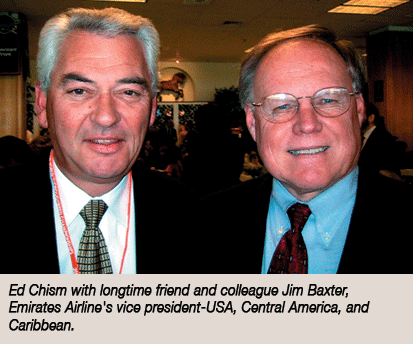 “Emirates
SkyCargo is far superior
to anything Pan Am Clipper
Cargo did or hoped to
become, even in its heyday. “Emirates
SkyCargo is far superior
to anything Pan Am Clipper
Cargo did or hoped to
become, even in its heyday.
“The
team is just great, headed
up by Ram who is both
a visionary and a great
leader.
“Ram
Menen knows where he wants
to bring the airline in
air cargo and beyond;
he has a very clear vision
of where the entire industry
needs to be moving ahead
in the 21st century.
“He
is truly unique in the
world right now when it
comes to air cargo.
“We
all are lucky that he
is on the global scene
the way he is, pushing
for air cargo change and
advancement in every aspect
of the business, from
e-freight to warehousing
to security, you name
it.
“Of
course, underpinning his
effort and legacy is his
work in building SkyCargo,
which will stand the test
of time.
“The
big challenge ahead is
about the same as before,
and that is getting forwarders
and governments to endorse
and practice utilizing
paperless air cargo or
e-freight.
“Here,
America is a good example
of the problem of putting
e-freight into practice.
“In
some cities you can do
paperless business with
exports, but not imports.
“In
other cities it can be
the other way around,
while in yet other USA
destinations it can be
all shipments or worse—not
allowing e-freight as
part of the supply chain
process at all.
“Everybody
knows that for real change,
there has to be a collaborative
effort across the board,
but no one seems to know
how and when that will
happen.”
You
listen to Ed Chism talk
and realize that rarely
(or maybe even never)
has this highly intelligent
and wizened air cargo
professional come off
the line of moving air
cargo, to tell it like
it is and express these
feelings.
Ed
is all about business.
Ed
Chism loves to move air
cargo, and although we
learned that he was off
on a family holiday after
our meeting, we could
feel that even then he
was looking forward to
getting back, to take
charge as Emirates expands
operations vigorously
across the USA to new
destinations, including
Washington, D.C. coming
this fall and most probably
Atlanta and Chicago sometime
shortly after that.
Often
during our afternoon together,
Ed would say:
“C’mon,
let’s go outside
and have a smoke.”
Without
a word we would stand
outside the small restaurant
and Ed would continue
the conversation, cigarette
in hand.
It
made me think of all the
years everybody just smoked
in business meetings with
several cups of coffee,
and how unusual it was
that anybody was still
smoking in 2012.
But
at one break, our waitress
followed us outside and
lit up a cigarette with
us.
So
there we were, two smokers
and one non, and I wondered
aloud why not just put
a table outside?
“The
USPS is moving to cooperate
with UPU and ICAO to try
and standardize some electronic
rules and procedures,”
Ed said, as aircraft overhead
moved in from the Atlantic
on a long aerial pathway
that would take them to
final just above Ed’s
old Building 67, a route
the pilots call “The
Canarsie Run” after
the Brooklyn neighborhood
just below the approach.
“Let’s
face it,” Ed said,
“change, whatever
the need, comes very slowly
to air cargo. Aside from
some information technology
driven by the Internet
and newer handling systems
that have come on line
during the past twenty
years, the air cargo business
has not changed all that
much over time.
“You
still make out airwaybills,
do consolidations, and
then book the cargo on
a flight.
“Pallets
are still built and airplanes
are still loaded as they
always were in air cargo.”
Today,
Emirates SkyCargo serves
six USA destinations and
(falling under one of
Ed Chism’s responsibilities)
has a GSA working cargo
in Mexico for the carrier.
In
addition to double dailies
to Dubai from JFK, EK
has a block space agreement
via Liege to Dubai with
TNT that moves an additional
250 tons a week, trucked
into the airport from
Chicago and elsewhere.
“The
new flights have been
well utilized and we are
looking forward to Washington
(Dulles) coming in September
with daily flights (B777s)
into Dubai—that
will help us accommodate
Washington, Baltimore,
Charlotte, Atlanta and
more.
“My
thought is that eventually
we might go to increased
freighter destinations
in USA as the market further
develops.
“But
we don’t want to
be bigger or broader-based
just for the sake of size—our
mission is superior service
and unusual customer relationships
driven by the brilliance
of our people and the
Emirates Mega Hub in Dubai.”
We
said goodbye to Ed Chism
with some promises to
get together again sometime.
Now
a few weeks later, through
that conversation with
Ed I can recall a time
when New York was the
center of the universe
for some truly great air
cargo executives who served
the famous international
flag airlines and freight
forwarders, during an
era when the top USA gateway
was here—the jewel
in the crown of any international
air cargo business.
These
few dozen people in various
positions, from the top
to the bottom, seated
in offices on and around
JFK International Airport,
changed history over decades,
and (among other achievements)
gave birth to industry
groups like CNS and TIACA
to create much of what
we know today as organized
air cargo.
There
is still some of that
breed out there among
us, like Ed Chism and
others, who still report
daily to JFK, and that
is a great comfort to
me.
In
Ed’s case, he has
come all the way back
to once again be a major
air cargo force at one
of the greatest airlines
in the world.
In
air cargo, Ed Chism has
already lived twice.
Geoffrey/Flossie
|



